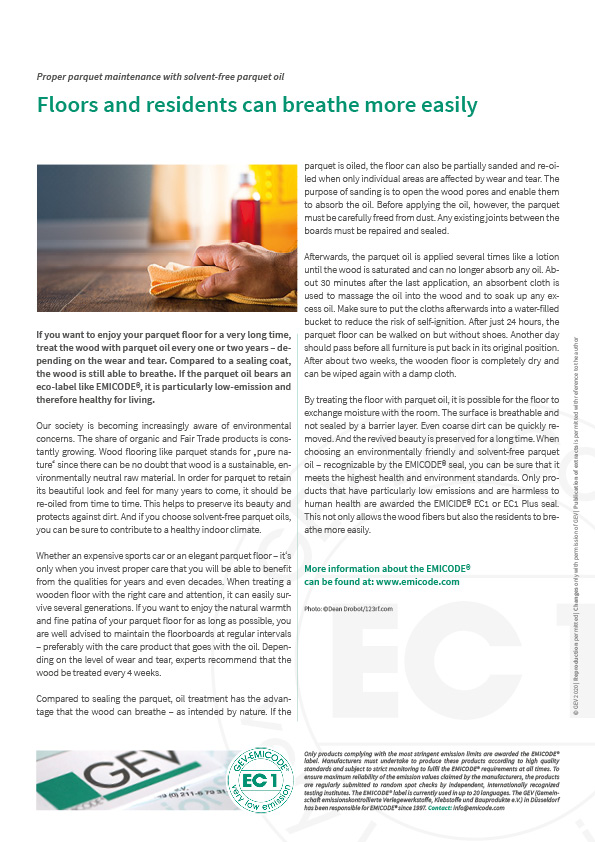Floors and residents can breathe more easily
Proper parquet maintenance with solvent-free parquet oil
Our society is becoming increasingly aware of environmental concerns. The share of organic and Fair Trade products is constantly growing. Wood flooring like parquet stands for “pure nature” since there can be no doubt that wood is a sustainable, environmentally neutral raw material. In order for parquet to retain its beautiful look and feel for many years to come, it should be re-oiled from time to time. This helps to preserve its beauty and protects against dirt. And if you choose solvent-free parquet oils, you can be sure to contribute to a healthy indoor climate.
Whether an expensive sports car or an elegant parquet floor – it’s only when you invest proper care that you will be able to benefit from the qualities for years and even decades. When treating a wooden floor with the right care and attention, it can easily survive several generations. If you want to enjoy the natural warmth and fine patina of your parquet floor for as long as possible, you are well advised to maintain the floorboards at regular intervals – preferably with the care product that goes with the oil. Depending on the level of wear and tear, experts recommend that the wood be treated every 4 weeks.
Compared to sealing the parquet, oil treatment has the advantage that the wood can breathe – as intended by nature. If the parquet is oiled, the floor can also be partially sanded and re-oiled when only individual areas are affected by wear and tear. The purpose of sanding is to open the wood pores and enable them to absorb the oil. Before applying the oil, however, the parquet must be carefully freed from dust. Any existing joints between the boards must be repaired and sealed.
Afterwards, the parquet oil is applied several times like a lotion until the wood is saturated and can no longer absorb any oil. About 30 minutes after the last application, an absorbent cloth is used to massage the oil into the wood and to soak up any excess oil. Make sure to put the cloths afterwards into a water-filled bucket to reduce the risk of self-ignition. After just 24 hours, the parquet floor can be walked on but without shoes. Another day should pass before all furniture is put back in its original position. After about two weeks, the wooden floor is completely dry and can be wiped again with a damp cloth.
By treating the floor with parquet oil, it is possible for the floor to exchange moisture with the room. The surface is breathable and not sealed by a barrier layer. Even coarse dirt can be quickly removed. And the revived beauty is preserved for a long time. When choosing an environmentally friendly and solvent-free parquet oil – recognizable by the EMICODE® seal, you can be sure that it meets the highest health and environment standards. Only products that have particularly low emissions and are harmless to human health are awarded the EMICIDE® EC1 or EC1 Plus seal. This not only allows the wood fibers but also the residents to breathe more easily.

Photo: ©stokkete/123rf.com
If you want to enjoy your parquet floor for a very long time, treat the wood with parquet oil every one or two years – depending on the wear and tear. Compared to a sealing coat, the wood is still able to breathe. If the parquet oil bears an eco-label like EMICODE®, it is particularly low-emission and therefore healthy for living.

Do You Have Questions?
If you have questions about specific topics or if you would like to contact us for any other reason, feel free to contact us by phone, fax or e‑mail.
Phone: +49 211 / 67931–20
Fax: +49 211 / 67931–33
info@emicode.com
Share article on Social Media:
